Interference Cancellation Based Spectrum Sharing for Massive MIMO Communication Systems
Abstract
1. Introduction
2. Materials and Methods
2.1. System Model
2.1.1. Mobile Communication System
2.1.2. Co-Existence RF Environment
2.1.3. Construction
2.2. Radar Mobile System Spectrum Sharing
2.2.1. Performance
2.2.2. Matrix Projection
2.3. Target Detection
- —
- represents the chi-squared noncentral dispensations, having 2 as degrees of freedom (DoF),
- —
- represents centralized chi-squared dispensations, having 2 as degrees of freedom (DoF). represents the noncentral parameter; it can be written as,
2.3.1. PD for Orthogonal Waveforms
2.3.2. PD for NSP Waveforms
3. Numerical Results
3.1. Analysis of Scenario 1
3.2. Analysis of Scenario 2
4. Discussion
| Algorithm 1. Projection for Algorithm 1 on 1st Scenario. |
| Iterate |
| For i = 1: Ҡ; |
| Obtain SSCI of from the replay of Antenna |
| Forward to Algorithm 2 for projection matrix generation |
| . |
| end for |
| Learn = |
| Define to be the desired projection. |
| Implement the null space projector: |
| End |
| Algorithm 2. Projection for Algorithm 2 on 1st Scenario. |
| If Algorithm 1 received interferences , next Execute Construct Construct Setup Projection Matrix Send to Algorithm 1. End |
| Algorithm 3. Projection Algorithm 3 on 2nd Scenario. |
| Iterate |
| By observation from Ҡ base stations obtain SSCI of H. |
| Forward Interference H to Algorithm 4 and create matrix P. |
| After Receiving matrix projection P through Algorithm 4. |
| Execute zero interference projection, |
| End |
| Algorithm 4. Projection Algorithm 4 on 2nd Scenario. |
| If Algorithm 3 has sent information to H, next |
| Execute H |
| Build |
| Build |
| Determine Matrix Projection |
| And matrix is forwarded to Algorithm 3. |
| End |
5. Conclusions
Author Contributions
Funding
Institutional Review Board Statement
Informed Consent Statement
Data Availability Statement
Acknowledgments
Conflicts of Interest
References
- Haykin, S. Cognitive radio: Brain-empowered wireless communications. IEEE J. Sel. Areas Commun. 2005, 23, 201–220. [Google Scholar] [CrossRef]
- Miantezila, M.; Guo, B.; Zhang, C.; Bai, X. Primary User Channel State Prediction Based on Channel Allocation and DBHMM. In Proceedings of the 2020 International Conference on Cyber-Enabled Distributed Computing and Knowledge Discovery (CyberC), Chongqing, China, 29–30 October 2020. [Google Scholar] [CrossRef]
- Kakalou, I.; Papadopoulou, D.; Xifilidis, T.; Psannis, K.E.; Siakavara, K.; Ishibashi, Y. A survey on spectrum sensing algorithms for cognitive radio networks. In Proceedings of the 2018 7th International Conference on Modern Circuits and Systems Technologies (MOCAST), Thessaloniki, Greece, 7–9 May 2018. [Google Scholar] [CrossRef]
- Murty, R.; Chandra, R.; Moscibroda, T.; Bahl, P. Senseless: A database-driven white spaces network. IEEE Trans. Mob. Comput. 2011, 11, 189–203. [Google Scholar] [CrossRef]
- Zhao, Y.; Morales, L.; Gaeddert, J.; Bae, K.K.; Um, J.-S.; Reed, J.H. Applying radio environment maps to cognitive wireless regional area networks. In Proceedings of the 2nd IEEE International Symposium on New Frontiers in Dynamic Spectrum Access Networks, Dublin, Ireland, 17–20 April 2007. [Google Scholar] [CrossRef]
- Gao, B.; Park, J.-M.J.; Yang, Y. Uplink Soft Frequency Reuse for Self-Coexistence of Cognitive Radio Networks. IEEE Trans. Mob. Comput. 2013, 13, 1366–1378. [Google Scholar] [CrossRef]
- Garnaev, A.; Trappe, W. Stability of communication link connectivity against hostile interference. In Proceedings of the 2017 IEEE Global Conference on Signal and Information Processing (GlobalSIP), Montreal, QC, Canada, 14–16 November 2017. [Google Scholar] [CrossRef]
- Khawar, A.; Abdelhadi, A.; Clancy, T.C. A mathematical analysis of cellular interference on the performance of S-band military radar systems. In Proceedings of the 2014 Wireless Telecommunications Symposium, Washington, DC, USA, 9–11 April 2014. [Google Scholar] [CrossRef]
- Commission, F.C. FCC Proposes Innovative Small Cell Use in 3.5 GHz Band. Available online: https://www.fcc.gov/document/fcc-proposes-innovative-small-cell-use-35-ghz-band (accessed on 20 May 2021).
- Khawar, A.; Ahmad, I.; Sulyman, A.I. Spectrum sharing between small cells and satellites: Opportunities and challenges. In Proceedings of the 2015 IEEE International Conference on Communication Workshop (ICCW), London, UK, 8–12 June 2015. [Google Scholar] [CrossRef]
- Cui, Y.; Koivunen, V.; Jing, X. Mutual Information Based Co-Design for Coexisting MIMO Radar and Communication Systems. In Proceedings of the 2020 IEEE International Conference on Communications Workshops (ICC Workshops), Dublin, Ireland, 7–11 June 2020. [Google Scholar] [CrossRef]
- Gower, R.M.; Richtárik, P.J. Stochastic Dual Ascent for Solving Linear Systems. arXiv 2015, arXiv:1512.06890. [Google Scholar]
- Griffiths, H.; Cohen, L.; Watts, S.; Mokole, E.; Baker, C.; Wicks, M.; Blunt, S. Radar Spectrum Engineering and Management: Technical and Regulatory Issues. Proc. IEEE 2015, 103, 85–102. [Google Scholar] [CrossRef]
- Rao, R.M.; Dhillon, H.S.; Marojevic, V.; Reed, J.H. Analysis of Worst-Case Interference in Underlay Radar-Massive MIMO Spectrum Sharing Scenarios. In Proceedings of the 2019 IEEE Global Communications Conference (GLOBECOM), Waikoloa, HI, USA, 9–13 December 2019. [Google Scholar] [CrossRef]
- Labib, M.; Martone, A.F.; Marojevic, V.; Reed, J.H.; Zaghloul, A.I. A Stochastic Optimization Approach for Spectrum Sharing of Radar and LTE Systems. IEEE Access 2019, 7, 60814–60826. [Google Scholar] [CrossRef]
- Liu, F.; Masouros, C.; Li, A.; Ratnarajah, T. Robust MIMO Beamforming for Cellular and Radar Coexistence. IEEE Wirel. Commun. Lett. 2017, 6, 374–377. [Google Scholar] [CrossRef]
- Liu, F.; Masouros, C.; Li, A.; Ratnarajah, T.; Zhou, J. MIMO Radar and Cellular Coexistence: A Power-Efficient Approach Enabled by Interference Exploitation. IEEE Trans. Signal Process. 2018, 66, 3681–3695. [Google Scholar] [CrossRef]
- Cadambe, V.R.; Jafar, S.A. Interference Alignment and Degrees of Freedom of the K-User Interference Channel. IEEE Trans. Inf. Theory 2008, 54, 3425–3441. [Google Scholar] [CrossRef]
- Suh, C.; Tse, D. Interference Alignment for Cellular Networks. In Proceedings of the 2008 46th Annual Allerton Conference on Communication, Control, and Computing, Monticello, IL, USA, 23–26 September 2008. [Google Scholar] [CrossRef]
- Jung, B.C.; Shin, W.-Y. Opportunistic Interference Alignment for Interference-Limited Cellular TDD Uplink. IEEE Commun. Lett. 2010, 15, 148–150. [Google Scholar] [CrossRef]
- Jung, B.C.; Park, D.; Shin, W.-Y. Opportunistic Interference Mitigation Achieves Optimal Degrees-of-Freedom in Wireless Multi-Cell Uplink Networks. IEEE Trans. Commun. 2012, 60, 1935–1944. [Google Scholar] [CrossRef]
- Yang, H.J.; Shin, W.-Y.; Jung, B.C.; Paulraj, A. Opportunistic Interference Alignment for MIMO Interfering Multiple-Access Channels. IEEE Trans. Wirel. Commun. 2013, 12, 2180–2192. [Google Scholar] [CrossRef]
- Yang, H.J.; Jung, B.C.; Shin, W.-Y.; Paulraj, A. Codebook-Based Opportunistic Interference Alignment. IEEE Trans. Signal Process. 2014, 62, 2922–2937. [Google Scholar] [CrossRef][Green Version]
- Jin, H.; Jeon, S.-W.; Jung, B.C. Opportunistic Interference Alignment for Random Access Networks. IEEE Trans. Veh. Technol. 2015, 64, 5947–5954. [Google Scholar] [CrossRef][Green Version]
- Jung, B.C.; Kim, S.M.; Shin, W.-Y.; Yang, H.J. Optimal Multiuser Diversity in Multi-Cell MIMO Uplink Networks: User Scaling Law and Beamforming Design. Entropy 2017, 19, 393. [Google Scholar] [CrossRef]
- Yang, H.J.; Shin, W.-Y.; Jung, B.C.; Suh, C.; Paulraj, A. Opportunistic Downlink Interference Alignment for Multi-Cell MIMO Networks. IEEE Trans. Wirel. Commun. 2017, 16, 1533–1548. [Google Scholar] [CrossRef]
- Yoon, J.; Kim, Y.; Jang, H.S.; Jung, B.C. Downlink Interference Alignment with Multi-User and Multi-Beam Diversity for Fog RANs. In Proceedings of the 2019 IEEE 90th Vehicular Technology Conference (VTC2019-Fall), Honolulu, HI, USA, 22–25 September 2019. [Google Scholar] [CrossRef]
- Kim, D.-H.; Youn, J.; Jung, B.C. Opportunistic Interference Alignment for Spectrum Sharing between Radar and Communication Systems. Sensors 2020, 20, 4868. [Google Scholar] [CrossRef]
- Amiri, R.; Behnia, F.; Sadr, M.A.M. Efficient Positioning in MIMO Radars With Widely Separated Antennas. IEEE Commun. Lett. 2017, 21, 1569–1572. [Google Scholar] [CrossRef]
- Sun, B.; Zhou, Y.; Yuan, J.; Shi, J. Interference Cancellation Based Channel Estimation for Massive MIMO Systems With Time Shifted Pilots. IEEE Trans. Wirel. Commun. 2020, 19, 6826–6843. [Google Scholar] [CrossRef]
- Li, J.; Stoica, P. MIMO Radar with Colocated Antennas. IEEE Signal Process. Mag. 2007, 24, 106–114. [Google Scholar] [CrossRef]
- Ulaby, F.; Dobson, M.C.; Álvarez-Pérez, J.L. Handbook of Radar Scattering Statistics for Terrain; Artech House: Norwood, MA, USA, 2019; ISBN 9781630817015. [Google Scholar]
- Khawar, A.; Abdel-Hadi, A.; Clancy, T.C.; McGwier, R. Beampattern analysis for MIMO radar and telecommunication system coexistence. In Proceedings of the 2014 International Conference on Computing, Networking and Communications (ICNC), Honolulu, HI, USA, 3–6 February 2014. [Google Scholar] [CrossRef]
- Skolnik, M.I. Radar Handbook; McGraw-Hill Education: New York, NY, USA, 2008. [Google Scholar] [CrossRef]
- Cui, Y.; Koivunen, V.; Jing, X. Interference Alignment Based Spectrum Sharing for MIMO Radar and Communication Systems. In Proceedings of the 2018 IEEE 19th International Workshop on Signal Processing Advances in Wireless Communications (SPAWC), Kalamata, Greece, 25–28 June 2018. [Google Scholar] [CrossRef]
- Deniz, U.E.; Candan, C. A low-complexity precoder-decoder design in multiuser downlink MIMO communication systems for common and private information transmission. In Proceedings of the 2018 26th Signal Processing and Communications Applications Conference (SIU), Izmir, Turkey, 2–5 May 2018. [Google Scholar] [CrossRef]
- Garg, N.; Jagannatham, A.K.; Sharma, G.; Ratnarajah, T. Precoder Feedback Schemes for Robust Interference Alignment With Bounded CSI Uncertainty. IEEE Trans. Signal Inf. Process. Netw. 2020, 6, 407–425. [Google Scholar] [CrossRef]
- Clerckx, B.; Zhang, R.; Schober, R.; Ng, D.W.K.; Kim, D.I.; Poor, H.V. Fundamentals of Wireless Information and Power Transfer: From RF Energy Harvester Models to Signal and System Designs. IEEE J. Sel. Areas Commun. 2019, 37, 4–33. [Google Scholar] [CrossRef]
- Babaei, A.; Tranter, W.H.; Bose, T. A nullspace-based precoder with subspace expansion for radar/communications coexistence. In Proceedings of the 2013 IEEE Global Communications Conference (GLOBECOM), Atlanta, GA, USA, 9–13 December 2013. [Google Scholar] [CrossRef]
- Li, J.; Stoica, P. MIMO Radar Signal Processing; Wiley Online Library: Hoboken, NJ, USA, 2009. [Google Scholar] [CrossRef]
- GUO, L.; Long, F.; Zhou, J.J.V.E. Resource Allocation with Carrier Aggregation of LTE-Advanced and S-Band Radar Carriers. Video Eng. 2015, 21. [Google Scholar] [CrossRef]
- Ghorbanzadeh, M.; Abdelhadi, A.; Clancy, C. A utility proportional fairness resource allocation in spectrally radar-coexistent cellular networks. In Proceedings of the 2014 IEEE Military Communications Conference, Baltimore, MD, USA, 6–8 October 2014. [Google Scholar] [CrossRef]
- Bekkerman, I.; Tabrikian, J. Target Detection and Localization Using MIMO Radars and Sonars. IEEE Trans. Signal Process. 2006, 54, 3873–3883. [Google Scholar] [CrossRef]
- Kay, S.M. Fundamentals of Statistical Signal Processing; Prentice Hall PTR: Hoboken, NJ, USA, 1993. [Google Scholar]
- Khawar, A.; Abdelhadi, A.; Clancy, C. Target Detection Performance of Spectrum Sharing MIMO Radars. IEEE Sens. J. 2015, 15, 4928–4940. [Google Scholar] [CrossRef]
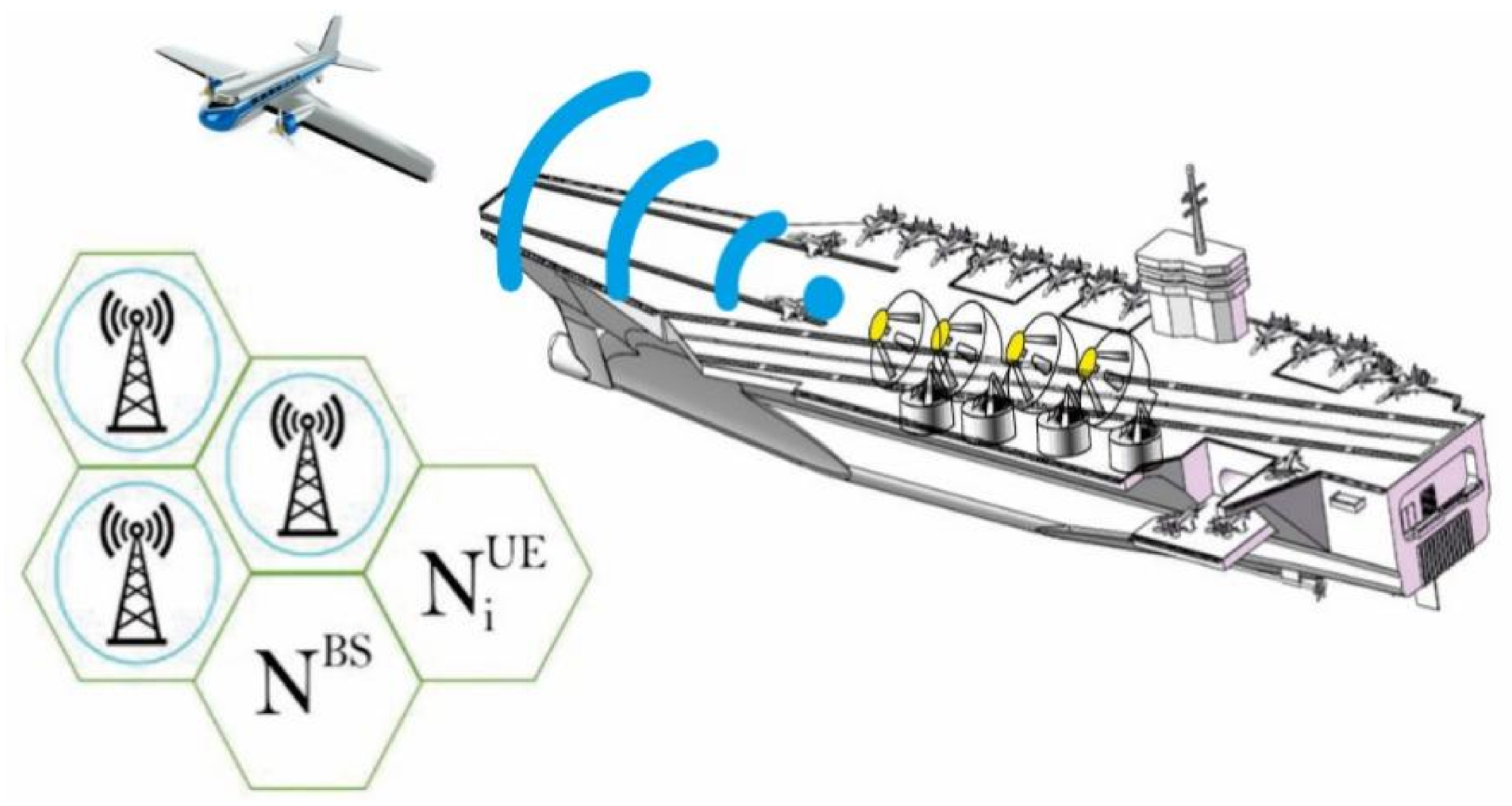
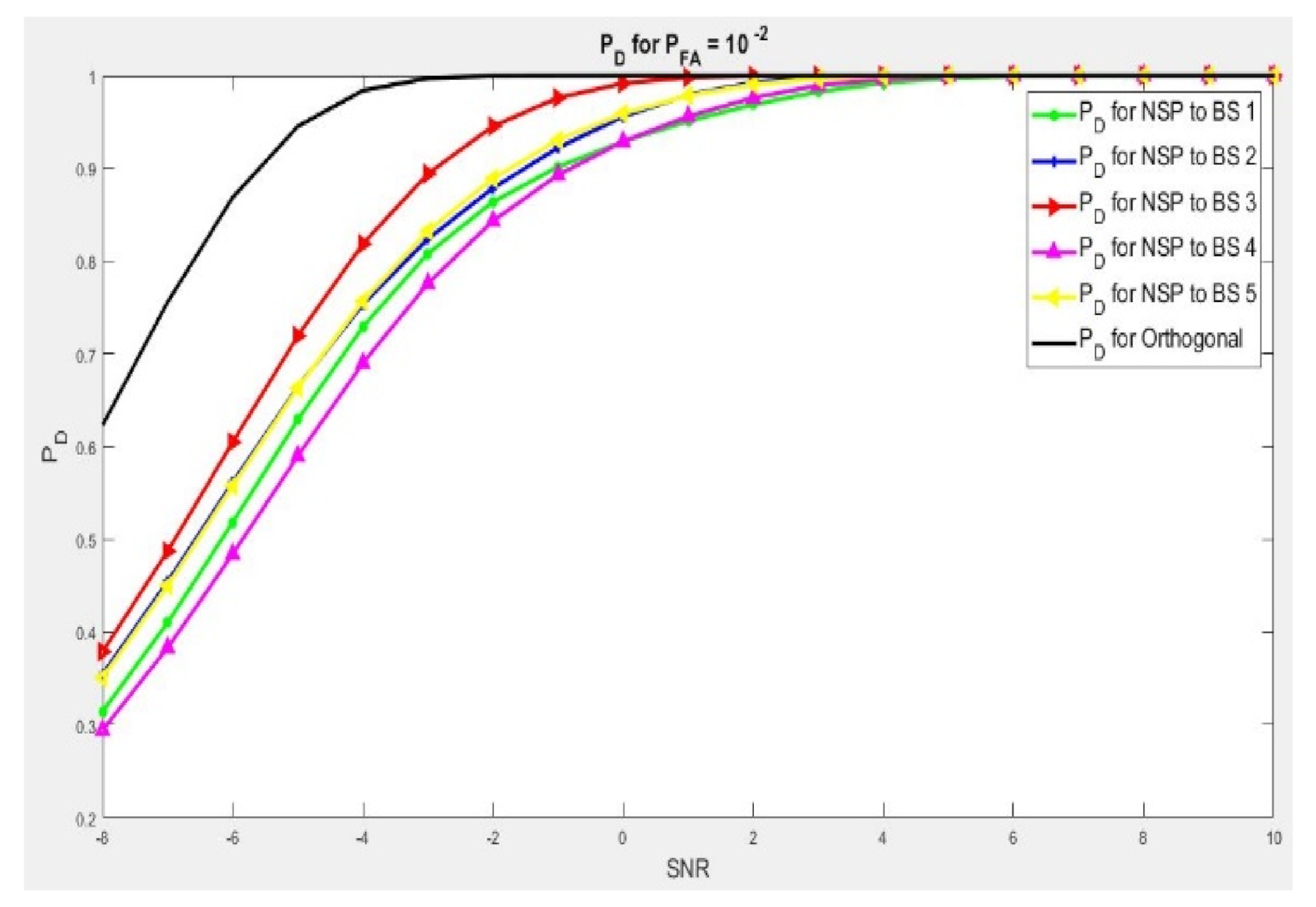
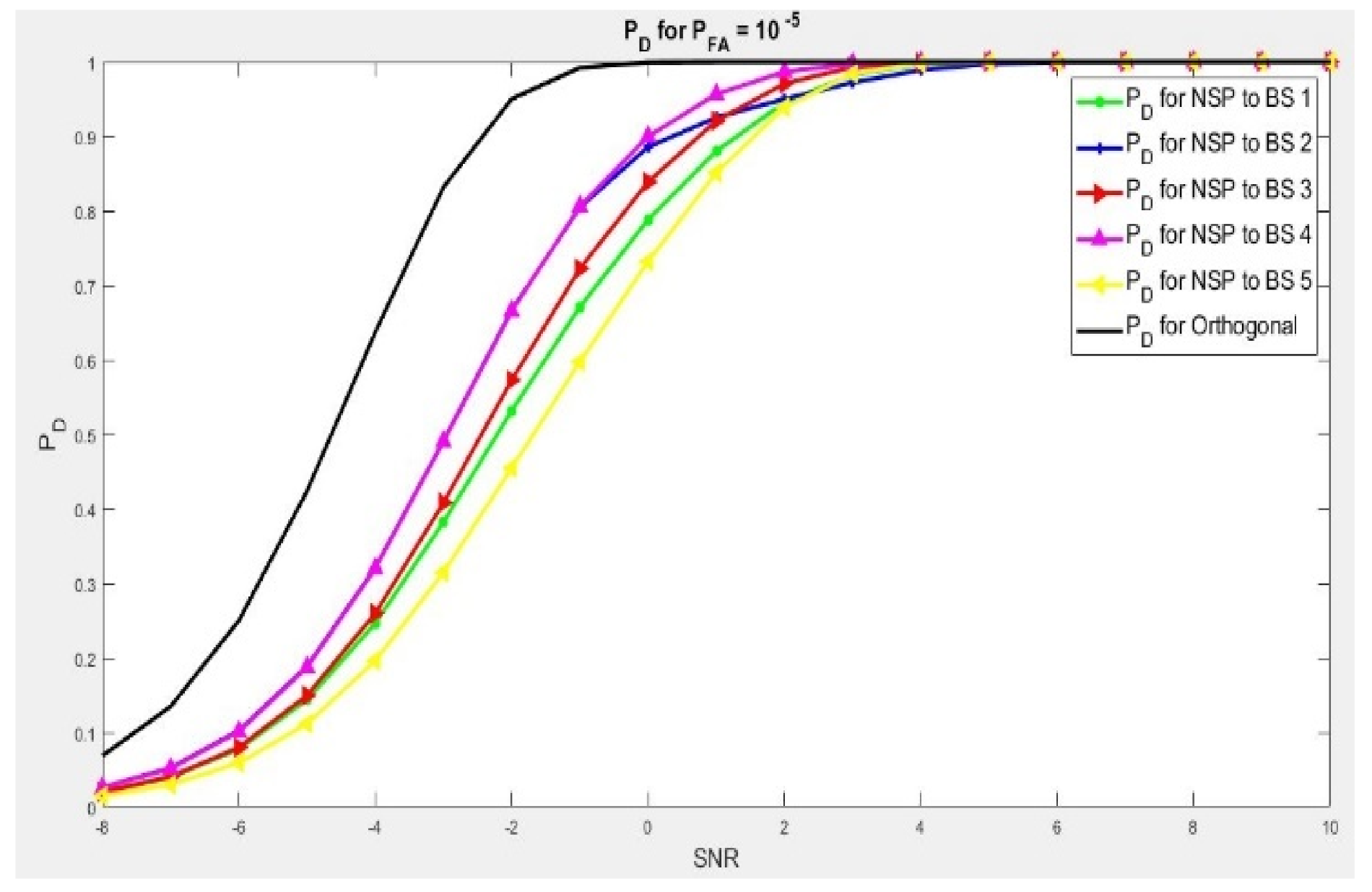
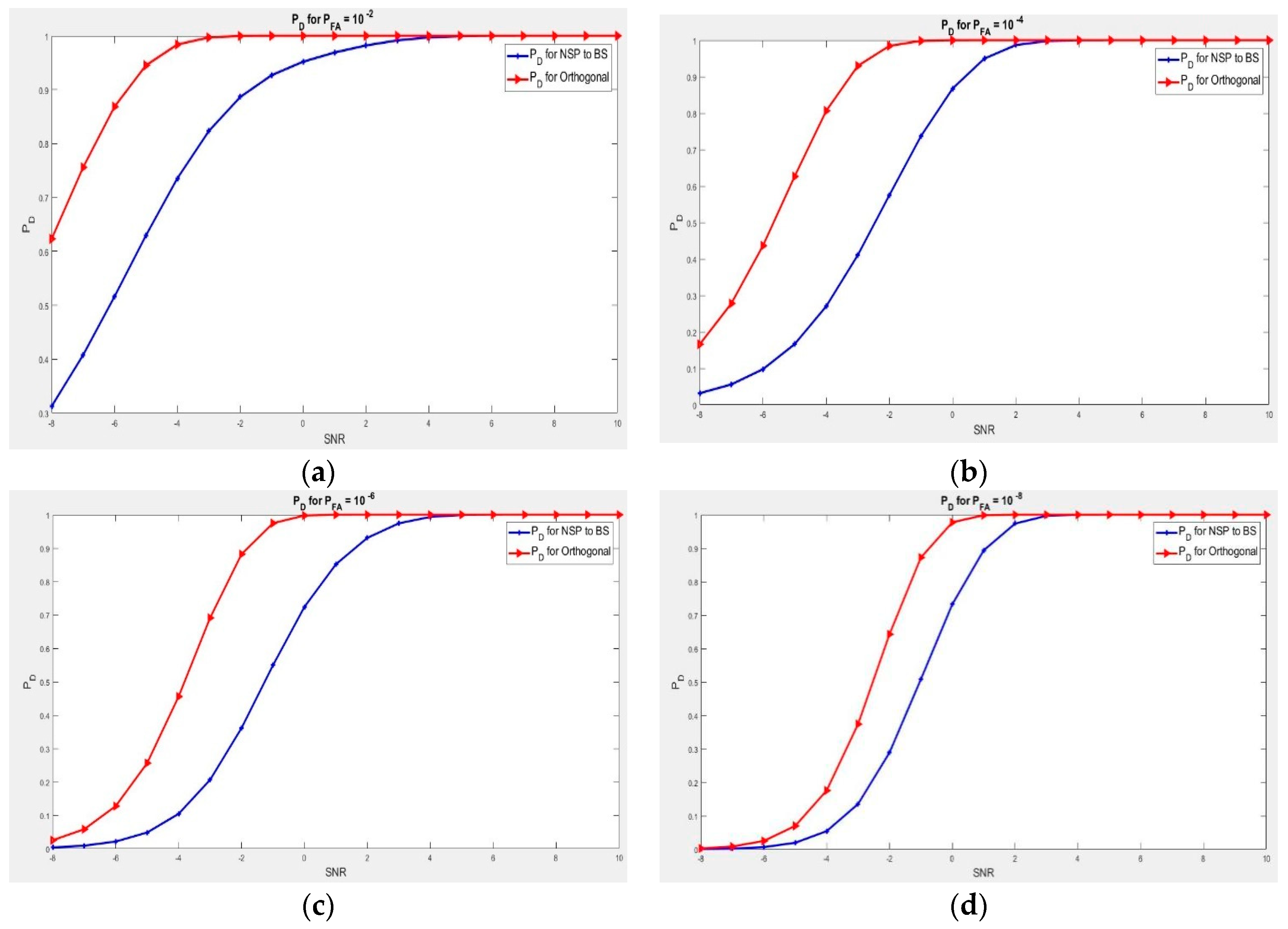
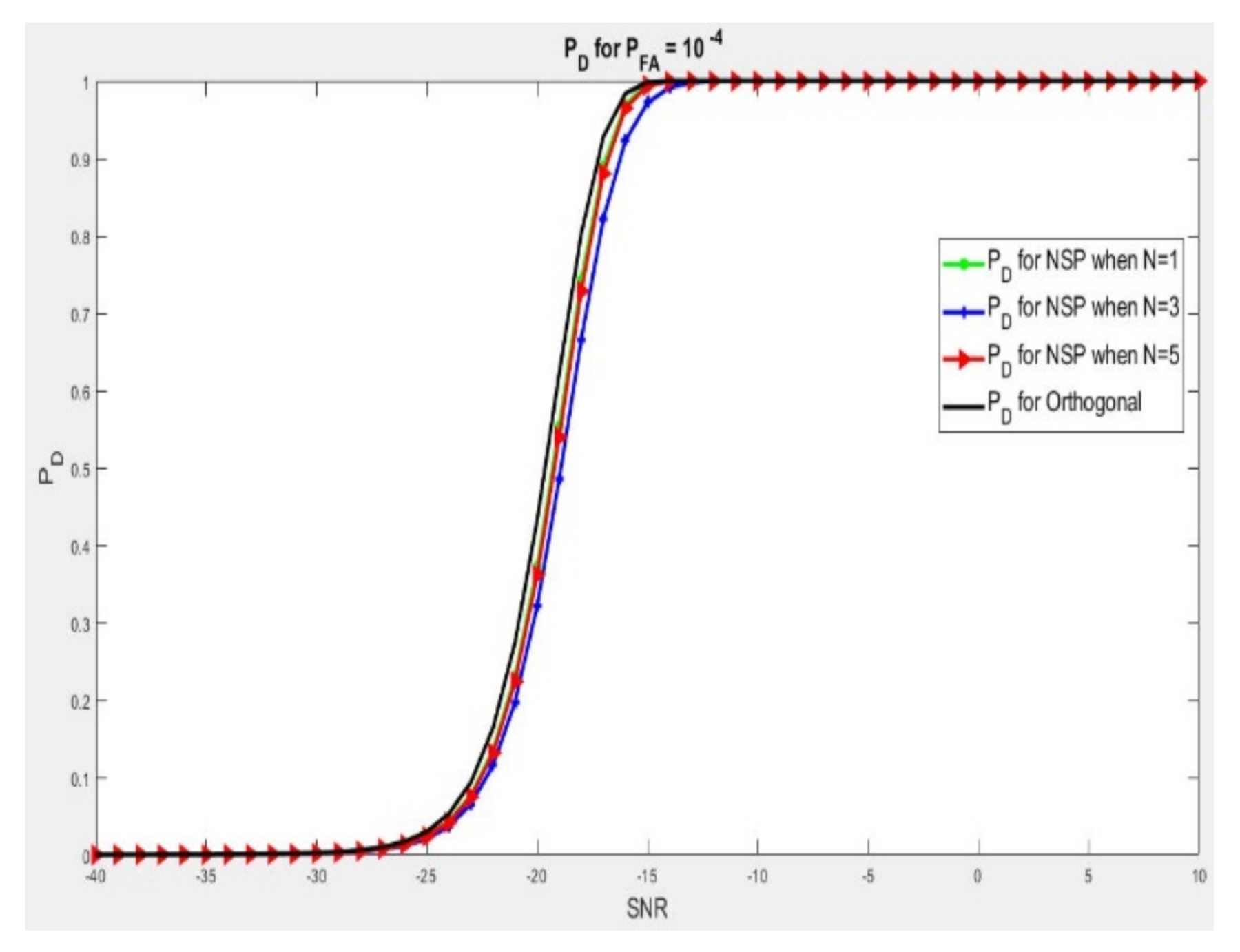
| Notations | Values |
|---|---|
| Radar Wave Transmitted | |
| Steering Vector Transmitted of Target angle θ | |
| Steering Vector Received of Target angle θ | |
| Transmit-Receive Steering Matrix | |
| Received Radar Wave | |
| Matrix of Correlation | |
| (t) | |
| Ҡ | Total Number of BSs |
| M | Radar Transmit Antenna |
| BS Transmit/Receive Antenna | |
| Parameters | Notations | Values |
|---|---|---|
| Radar & LTE Communication RF Band | - | 3550–3650 MHz |
| Radar Antenna Tx/Rx | M | 10/4 |
| LTE Communication System Antennas | 5 | |
| Carrier Frequency | 3.55 GHZ | |
| Wavelength | λ | 8.5 cm |
| Antenna Inter Spacing | 3λ/4 | 6.42 cm |
| Radial Velocity | 1000 m/s | |
| Speed of Light | c | 3 × m/s |
| Target point | 400 Km | |
| Angle of Target | ||
| Doppler Frequency | 2/c | |
| Two-way breeding holdup, | 2/c | |
| Path loss | α |
Publisher’s Note: MDPI stays neutral with regard to jurisdictional claims in published maps and institutional affiliations. |
© 2021 by the authors. Licensee MDPI, Basel, Switzerland. This article is an open access article distributed under the terms and conditions of the Creative Commons Attribution (CC BY) license (https://creativecommons.org/licenses/by/4.0/).
Share and Cite
Junior, M.M.; Guo, B.; Zhang, C.; Bai, X. Interference Cancellation Based Spectrum Sharing for Massive MIMO Communication Systems. Sensors 2021, 21, 3584. https://doi.org/10.3390/s21113584
Junior MM, Guo B, Zhang C, Bai X. Interference Cancellation Based Spectrum Sharing for Massive MIMO Communication Systems. Sensors. 2021; 21(11):3584. https://doi.org/10.3390/s21113584
Chicago/Turabian StyleJunior, Milembolo Miantezila, Bin Guo, Chenjie Zhang, and Xuemei Bai. 2021. "Interference Cancellation Based Spectrum Sharing for Massive MIMO Communication Systems" Sensors 21, no. 11: 3584. https://doi.org/10.3390/s21113584
APA StyleJunior, M. M., Guo, B., Zhang, C., & Bai, X. (2021). Interference Cancellation Based Spectrum Sharing for Massive MIMO Communication Systems. Sensors, 21(11), 3584. https://doi.org/10.3390/s21113584







